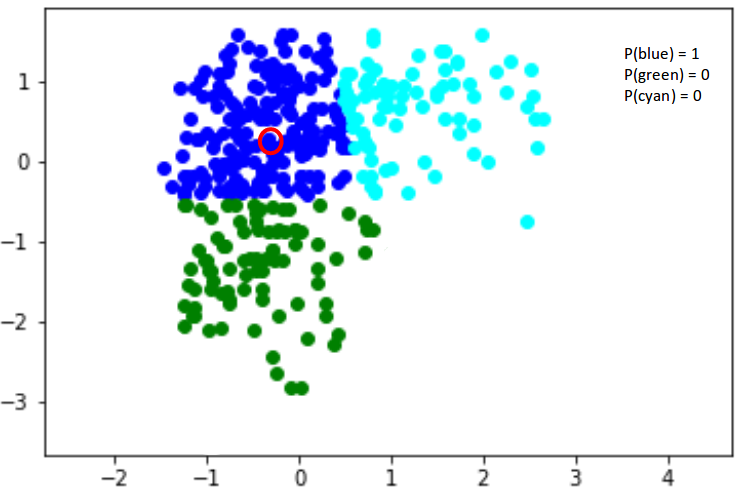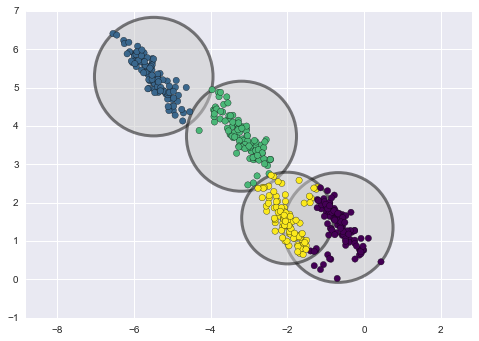Gaussian Mixture Models Clustering - Explained. The GMM approach is similar to K-Means clustering algorithm but is.
A GMM represents a composite distribution of independent Gaussian distributions with associated mixing weights specifying eachs contribution to.

. The number of mixture components. From sklearnmixture import GMM gmm GMMn_components4fitX labels gmmpredictX pltscatterX 0 X 1 clabels s40 cmapviridis. GMM in Python with sklearn.
One of the key parameters to use while fitting Gaussian Mixture model is the number of clusters in the dataset. Key concepts you should have heard about are. Gaussian Mixture Model is a clustering model that is used in unsupervised.
Read more in the User Guide. But since there are K such clusters and the probability density is defined as. Clustering Problem formulation Algorithms Choosing the number of clusters Gaussian mixture model GMM A probabilistic approach to clustering GMM clustering as an optimisation problem 2.
Gaussian-Mixture-Model-from-scratch Output of final cluster Requirements. So and is also estimated for each k. Had it been only one distribution they would have been estimated by the maximum-likelihood method.
Implementing Gaussian Mixture Model in Machine Learning using Python. Gaussian Mixture Model. Instead of estimating the mean and variance for each Gaussian now we estimate the mean and the covariance.
The Gaussian Mixture Models GMM algorithm is an unsupervised learning algorithm since we do not know any values of a target feature. Data for fitting Gaussian Mixture Models Python Fitting a Gaussian Mixture Model with Scikit-learns GaussianMixture function. Covariance_typefull tied diag spherical.
In the simplest case GMMs can be used for finding clusters in the same manner as k -means. Python Credit Card Dataset for Clustering. In this post Ive implemented unsupervised clustering of Iris dataset using Gaussian mixture models GMM in pythonA detailed introduction about GMM is available on this Wikipedia pageThe original implementation of the code was done by McDickenson available here in Github - considering two Gaussian mixture model as inputs.
For relatively low-dimensional tasks several dozen inputs at most such as identifying distinct consumer populations K-means clustering is a. It is a clustering algorithm having certain advantages over kmeans algorithm. Suppose there are K clusters For the sake of simplicity here it is assumed that the number of clusters is known and it is K.
This class allows to estimate the parameters of a Gaussian mixture distribution. The covariance is a squared matrix of shape D D where D represents the data dimensionality. Implementation of Gaussian Mixture Model trained using Expectation-Maximization algorithm to perform soft gaussian clustering.
Implementing Gaussian Mixture Model from scratch using python class and Expectation Maximization algorithm. However now I would like to use a different approach and use Gaussian Mixture Model for Clustering the data into 2 classes. For Gaussian Mixture Models GMMs model GMM_conc data For GMMs which share the same covariance matrix for all components model MFA data For Mixture of Factor Analyzers model PGMM dataconstraintUUU.
Implementing Gaussian Mixture Model using Expectation Maximization EM Algorithm in Python on IRIS dataset. For high-dimensional data D1 only a few things change. EM algorithm and Gaussian Mixture Model GMM with sample implementation in Python Preface.
This class performs expectation maximization for multivariate Gaussian Mixture Models GMMs. With scikit-learns GaussianMixture function we can fit our data to the mixture models. GMM is a soft clustering algorithm which considers data as finite gaussian distributions with.
Representation of a Gaussian mixture model probability distribution. I have gone through Scikit-Learn documentation and other SO questions but am unable to understand how I can use GMM for 2 class clustering in my present context. Mixture means the mixture of more than.
Here Gaussian means the Gaussian distribution described by mean and variance. T he Gaussian mixture model GMM is well-known as an unsupervised learning algorithm for clustering. K-means clustering Gaussian mixture models and spectral clustering.
Python The Enron Email Dataset Private Datasource. This article aims to provide consolidated information on the underlying topic and is. Python implementation of Gaussian Mixture RegressionGMR and Gaussian Mixture ModelGMM algorithms with examples and data files.
Here Ive modified the code. Several data points grouped together into various clusters based on their similarity is called clustering. Gaussian Mixture Models for 1D data using K equals 2.
Once you have a some input data choosing a model is relatively straightforward. Model GMM data. GitHub - saniikakulkarniGaussian-Mixture-Model-from-scratch.
Statistical Machine Learning S2 2017 Deck 13 Unsupervised Learning. New in version 018. Python features three widely used techniques.
Gaussian mixture models is a popular unsupervised learning algorithm. The sklearnmixture package allows to learn Gaussian Mixture Models and has several options to control how many parameters to include in the covariance matrix diagonal spherical tied and full covariance matrices supported. Further the GMM is categorized into the clustering algorithms since it can be used to find clusters in the data.
SklearnmixtureGaussianMixture uses Expectation-Minimization as previously explained.

Gaussian Mixture Models Clustering Algorithm Python

Gaussian Mixture Models Clustering Algorithm Python

Clustering With Gaussian Mixture Models Python Machine Learning

Gaussian Mixture Model Clustering Is An Unsupervised Learning By Yara Amin Medium

Gaussian Mixture Models Clustering Algorithm Explained By Cory Maklin Towards Data Science
Clustering With Gaussian Mixture Model By Azad Soni Clustering With Gaussian Mixture Model Medium

Gaussian Mixture Models Clustering Algorithm Explained By Cory Maklin Towards Data Science
0 komentar
Posting Komentar